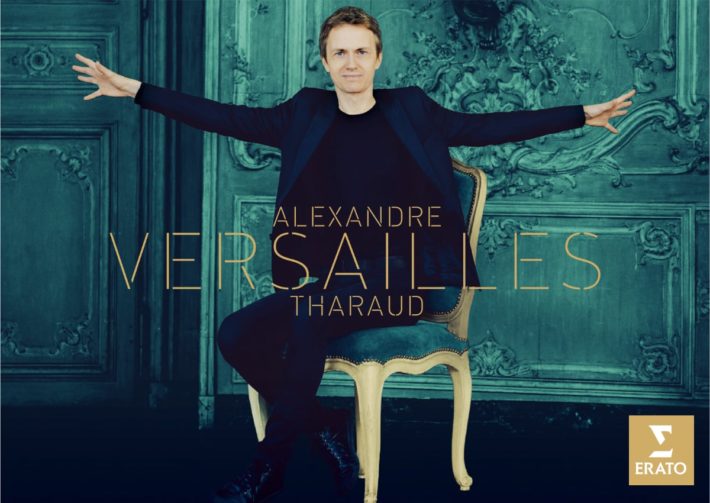Alexandre Tharaud releases a new album of works by 18th-century French composers including Couperin, Rameau, Lully, Royer, and d’Anglebert. Aptly titled, “Versailles” is a reflection upon the music of the courts of Louis XIV-XVI. Tharaud, who has a diverse discography ranging from Couperin to Satie, releases this album nearly two decades after his highly successful 2001 debut, “Rameau: Nouvelles Suites de Pièces de Clavecin” (Amazon). The works on “Versailles” were originally written for the harpsichord, but Tharaud, using the instrument’s modern cousin, brings them to light in a new dimension.

Throughout the album, the performer not only shows a good understanding of the coloristic capabilities of the piano, but also respects the harpsichord idiom; there is a good overarching balance between a warm tone and succinct clarity of articulation. While it may be tempting for a pianist to ‘romanticize’ these works on the modern instrument through overpedaling and excessive rubato, Tharaud maintains a firm stylistic control.
Tharaud’s interpretation of Rameau’s “Suite en la” (track 6) shows his aforementioned artistry across a theme and variations. Beautiful ornamentation is coupled with fine clarity in the opening theme. His approach to the music’s polyphony is well thought-out in terms of individual character of each line, using the piano’s different timbres of each register effectively, so that each line can be clearly deciphered. Yet at the same time, all sound integrated as part of a larger picture. Listen, as an example, to the way Tharaud incorporates the upper register so clearly yet so subtly and well-controlled against the middle register at 1’12”.
There are, however, just a couple of issues with his presentation of this piece. First is that the lyricism of the piece is sometimes interrupted by overly-accented chords. Given the subtle nuances of the preceding section, these chords seem to emerge unexpectedly, sounding a little shrill (his overall approach to this piece, one must admit, is more pointed than his first attempt at the entire suite in 2001). The second issue is a little larger in scale: after sustaining listening, the variations do start to sound a little too consistent and similar in style. A greater character changes between the variations could have made the piece really come alive. One point where he does this very well occurs at 3’53, marked by sharper articulation and a more sprightly nature, contrasting with the overall lyricism of the piece.
The pianist’s lyricism is best shown in Couperin’s Les Ombres Errantes (Track 11). Translated into English, this title reads along the lines of “The Wandering Shadows”. Tharaud takes this title to heart, infusing the work with a pensive melancholy. He uses the warm middle register of the piano to great effect: the delicate melody at the opening not only sings, but also speaks most sensitively. Given that this piece is slow and meandering in character, it is possible for a performer to lose the sense of the overall architecture and momentum. Tharaud, however, pays careful attention to these details. His interpretation maintains a consistent pacing that not only complements the shapes of the phrases, but also has a degree of fluidity, which enhances the lyricism of the piece.
One of the most impressive and interesting performances here is Royer’s La Marche des Scythes (track 8). Royer was known as a virtuosic composer, and this piece certainly shows off the performer’s skills through arpeggios, ornaments, and runs. Interestingly, Royer also makes very effective use of the lower register, which on the harpsichord has quite a menacing presence. In listening to this work on a harpsichord (Jean Rondeau is a good proponent, in his 2016 Erato recording), the listener can immediately sense that Tharaud takes great care of replicating the harpsichord’s timbre; the opening is sharp, growling, and almost spiney, capturing the metallic timbre of the original instrument. With a rather eccentric and eclectic juxtaposition of characters, this is an example of a piece where a performer might be carried away with over-exploiting the power and sonorities of the piano, but once again, Tharaud’s playing is thoughtfully observant of the style of the Baroque period.
The sound engineering is well done, giving the piano a very “close-up” quality. Reverb is also noticeably absent here, which truly enhances the warm nature of Tharaud’s playing and is consistent with the stylistic idiom of the pieces. The accompanying booklet includes an interview with Tharaud, where he speaks about his choice of pieces and how he feels personally about each of the composers. It is a must-read as much as the album is a must-listen.
“Versailles”
Alexandre Tharaud – Piano
Erato, CD 0190295386429




















